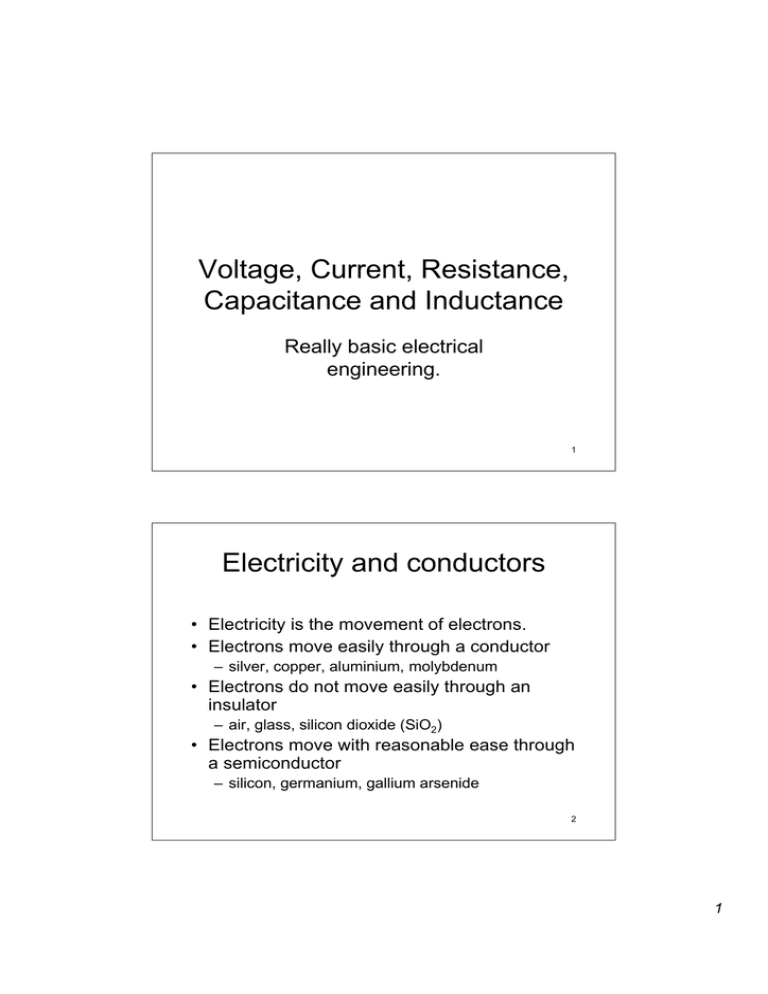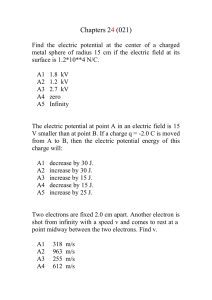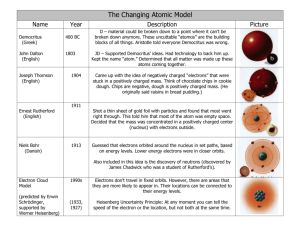Voltage, Current, Resistance, Capacitance and Inductance
advertisement

Voltage, Current, Resistance, Capacitance and Inductance Really basic electrical engineering. 1 Electricity and conductors • Electricity is the movement of electrons. • Electrons move easily through a conductor – silver, copper, aluminium, molybdenum • Electrons do not move easily through an insulator – air, glass, silicon dioxide (SiO2) • Electrons move with reasonable ease through a semiconductor – silicon, germanium, gallium arsenide 2 1 Electrons and protons • Normally, materials have the same number of electrons – which carry a negative charge • …and protons – which carry a positive charge • and such materials carry no (net) charge 3 Potential difference: volts: • When there is an imbalance of electrons and protons in a material, the material carries an electric charge • If there are too many electrons – the material is negatively charged (-ve) • If there are too few electrons – the material is positively charged (+ve) • If two pieces of material have differing charges, there is a potential difference between them – Measured in Volts. 4 2 Potential difference ct’d • If two pieces of material have differing charges, there is said to be a potential difference between them • The potential difference is measured in volts • The potential of the place with fewer electrons is higher than that of the place with more electrons V 5 Flow of electrons: Current • If materials with a potential difference are connected by a conductor, electrons will tend to move so that their charges equalise. • Electrons flow from the more negatively charged to the less negatively charged place • Electron flow is from the less positively charged to the more positively charged place • When electrons move, a current is said to flow – so a current is the flow of electrons through something – current is measured in amperes (or amps) 6 3 Current flow • Unfortunately, the conventional notation is the other way round from electron flow – a positive current flow occurs in the direction opposite to the actual flow of electrons Electron Flow Conductor Current Flow (amps) More negatively charged More positively charged 7 Resistance • A property of all materials, relating to how well they can carry electricity. • Conductor: low resistance • Insulator: high resistance. • Measured in Ohms Ω. Symbol R. • Often kilohm, megohm, or gigohm. 8 4 Ohms Law There is a relationship between potential difference, current flow, and resistance, called Ohms Law: V=IR – V is potential difference in volts – I is current flow in amps – R is resistance in ohms. • Thus, if V= 1 volt, R=10 ohms, a current of 0.1 amps would flow + V R Voltage Source I 9 Capacitance • • • • A property of electrical systems. Relates to building up an electric field. And to how much electricity they store Measured in Farads, F (huge). Symbol C. • (usually microfarads µF, or nanofarad nF or picofarad (pf) or even femtofarads) 10 5 Inductance • A property of wires. • Relates to them building up a magnetic field • Measured in Henrys. Symbol L. • Often millihenries, or microhenries…) 11 Why does this matter? • Electronic digital computers often need to move digital signals from place to place – From CPU to memory – From CPU register to register, etc. • Moving electrical signals along wires always involves R, C, L. 12 6 Digital signals • Digital electronic signals usually use one voltage to represent 0, and another to represent 1. • Voltage (potential difference) measured with respect to ground • 0 volts Logic 0 • 5 volts Logic 1 – Often not 5 volts, but 3, or 2.7 or 1.5… – Actual signal is analogue • Interpretation (0 or 1) changes at some in-between voltage 13 Why is this of interest? • Real digital signals change rapidly • Problem: sudden changes get made less sudden! volts in out 14 7 Example: simple RC circuit • R is resistance of a wire, C is capacitance of wire • Input is square wave • Output rises and falls more slowly 15 What can go wrong? • If the frequency of the input is high, • And R and C are (relatively) large, • Output signal may not reach the 1 state, before the signal starts to fall, • Then errors will occur. 16 8



